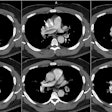Radiographics 2002 Oct;22 Spec No:S3-19; discussion S20-4
Combined CT venography and pulmonary angiography: a comprehensive review.
Katz DS, Loud PA, Bruce D, Gittleman AM, Mueller R, Klippenstein DL, Grossman ZD.
The combination of computed tomographic (CT) venography and pulmonary
angiography (CTVPA) was initially described in 1998 as a single comprehensive
noninvasive imaging examination for suspected thromboembolic disease. It allowed
the identification of pulmonary embolism as well as deep venous thrombosis (DVT)
in the abdomen, pelvis, thighs, and calves. The venographic portion of CTVPA has
now been studied by multiple researchers and has been shown to be an accurate
imaging study for the thigh veins in comparison with lower extremity sonography.
In contrast to sonography, however, CTVPA readily and rapidly permits evaluation
of the inferior vena cava, the pelvic veins, the calf veins, and all of the
superficial venous system. Complex venous anatomy can be surveyed, an additional
sonographic study is not required, and only a few extra minutes and images are
required over and above CT pulmonary angiography. A review of 957 recent cases
of suspected pulmonary embolism examined with CTVPA revealed an overall 10.5%
frequency of DVT, with a nearly equal distribution of thrombosis at the common
femoral, superficial femoral, popliteal, and deep calf veins. Although a variety
of protocols for CTVPA may be implemented, including a contiguous helical
acquisition, obtaining 5- or 10-mm-thick images every 4 cm provides a high
degree of accuracy and decreases overall radiation dose. Copyright RSNA, 2002







